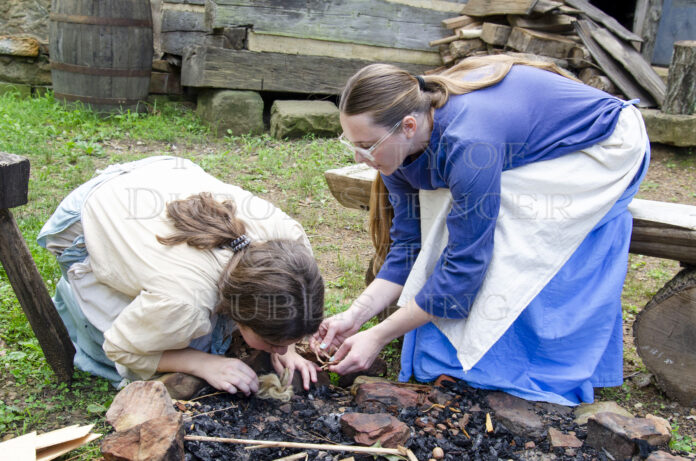By Don Steen
Staff Writer n reporter@psci.net
It was a busy Thursday for the Lincoln Boyhood National Memorial, including for the two new employees at the Living Historical Farm. Since the establishment of Juneteenth National Independence Day in 2021, the National Parks Service has opened its facilities and grounds to the public free of charge to celebrate the end of slavery in the United States. The waiving of park fees doesn’t particularly apply to the Memorial, as it is always open free of charge, but Juneteenth holds a special significance for the namesake of this Spencer County Landmark. New intern Emerson Rondy of Michigan and seasonal worker Julia Schreck of Ohio worked hard to bring the Living Historical Farm to life, so visitors could see how the Great Emancipator grew to manhood in Indiana.
It was a bit of a hectic day for the park’s newest hires. One of the sheep got loose in a bid to visit its friends and neighbors, the horses. Once the livestock were corralled, Schreck and Rondy set about the task of getting a fire going to demonstrate how meat was prepared and preserved in the farm’s smokehouse. They managed a spark from flint and steel easily enough, but coaxing a flame in the muggy Indiana air took some patience and perseverance. They also had to drop that chore to greet a steady flow of guests making use of the federal holiday to explore the park.
That was just the start of the morning, and it also happened to be Schreck’s first day on the job.
Efforts to preserve the legacy of Lincoln’s boyhood years date back to the late 19th Century, but it was not until 1962 that Congress formally recognized the formerly state-operated memorial and placed it under NPS supervision. The push to establish a replica Lincoln homestead near the original cabin site followed shortly.
In 1966, the U.S. Department of Agriculture and the Smithsonian Institute launched a joint venture to establish a nationwide system of living historical farms representing different places and time periods. NPS Director George Hartzog selected LBNM as one such site following a visit to the grounds in 1968. Extensive research into the Lincoln family’s Indiana homestead was undertaken, and a replica cabin, smokehouse, kitchen garden and other features were laid out.
The site was cleared in February of 1968, and by March 10 local residents skilled in log construction were hired to take on the project. Much of the material for the log structures was taken from existing buildings within the county. These included the Reisz barn from just west of Chrisney, the Bryant house from the Gentryville area and the Butler house from between Grandview and Rockport, which was purported to be more than 125 years old at the time. Most of the work was carried out with traditional hand tools that the Lincolns would have had to rely on upon their arrival in 1816.
In the end, the Living Historical Farm had a replica cabin, a smokehouse, chicken coop and barn. A carpenter shop was added in the spring of 1969.
Much like the Lincoln Boyhood National Memorial, the Juneteenth holiday had a winding track to federal recognition. While Lincoln issued the Emancipation Proclamation on January 1, 1863, this measure only applied to those territories in rebellion and not those slave-holding states still loyal to the Union. The 13th Amendment was passed by Congress on January 31, 1865 and would be ratified by year’s end, despite the assassination of Lincoln in April of that year.
The historical significance of June 19 stems from the final end of Confederate rule in the south, which extended sometime after General Robert E. Lee’s surrender at Appomattox. The Confederate Army of the Trans-Mississippi did not surrender until June 2, 1865. Seventeen days later, Union Major General Gordon Granger arrived at the island of Galveston in Texas to enforce the emancipation of the enslaved population there. One the one-year anniversary of that occasion, the freedman of that city organized the first “Jubilee Day”.
Juneteenth celebrations would spread across the country, carried by African American populations migrating out of the South. Though the holiday suffered a decline in the wake of Jim Crow restrictions and the passing of the first generation of freedmen, it saw a resurgence during the Civil Rights Movement of mid-20th Century. States gradually adopted the holiday over the years until Congress formally recognized it as a federal holiday on June 19, 2021, the first national holiday to be declared since Martin Luther King Jr. Day.
One doesn’t need a holiday for an excuse to visit the Lincoln Boyhood Memorial, however. Guests of Holiday World and other Santa Claus attractions regularly make the short trip to check out Lincoln’s childhood home. While the landscape has changed somewhat, one can always count on costumed interpreters to bring the Living Historical Farm to life now through the summer season.
Featured Image: Living Historical Farm staff Emerson Rondy and Julia Schreck work to coax a fire from sparked tinder Thursday morning. The process was a bit difficult due to recent rains and high humidity.

Jack Tanner splits some firewood with the help of park interpreter Connie Lutchy.






